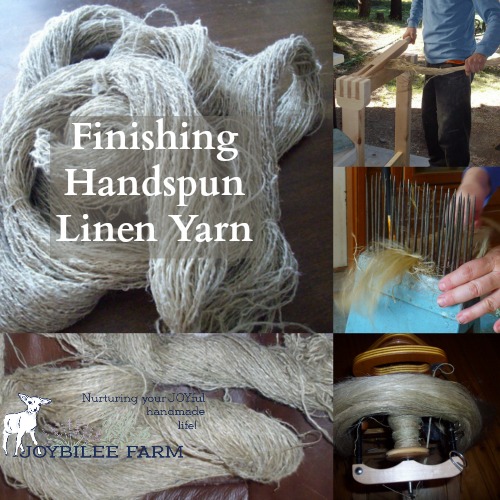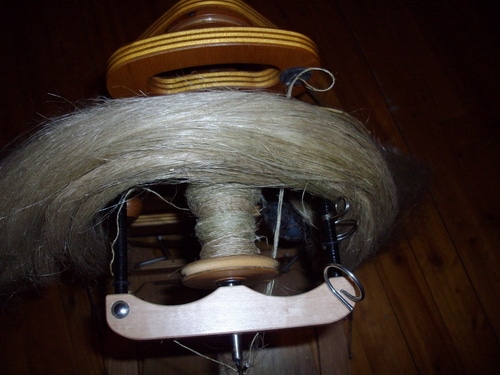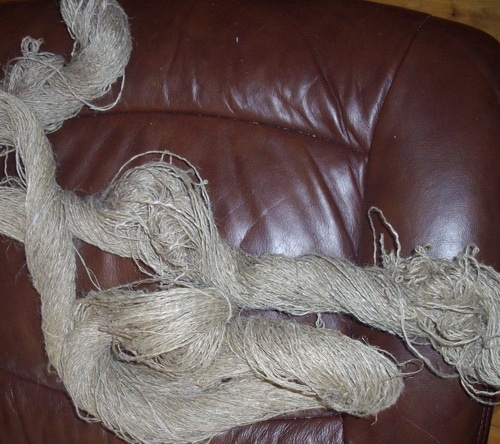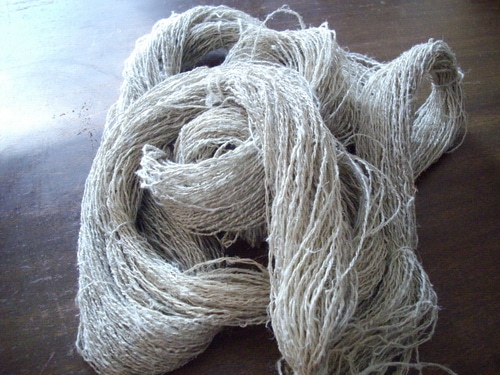Finishing Handspun Linen Yarn
Handspun linen yarn needs special handling and special finishing techniques before you weave with it.
Working with handspun linen yarn
One of the easiest fibres to grow on your homestead, for clothing and household textiles is linen. It doesn’t require extra fertilizer. It can grow in most climates with at least a one month growing season and isn’t damaged by light frosts during the growing season, flowering, or seed production. Linen is self-pollinating and if your plants can finish flowering in your climate zone, you can get a successful linen crop. The seeds will continue to mature even after the plants are harvested. A mere month after harvesting, the stocks can be rippled and you can easily save seed from this year’s crop to plant next year’s field.

Spinning linen is a bit different than spinning wool or other protein fibres, but while the technique is different, the time commitment is similar for the same yardage. However, once the fibre is spun, the resulting handspun yarn must be finished. Finishing linen is a totally unique process. Linen is a different fibre from most of the traditional handspun fibres like wool, mohair, and silk. It is a bast fibre. That means that the fibre is in the outside of the stem of the plant, not in the centre core of the plant, as is commonly thought. The fibres are held in place by pectin, a sticky substance that acts like starch or glue to give stiffness to the stem and to keep everything together. The retting process, a controlled rotting, removes some of the pectins and allows the fibres to separate in bundles from the stem. These bundles of fibres are further separated by hackling in traditional flax preparation for spinning.

But once the fibres are spun, plied if wanted, the finished handspun yarn is anything but pretty. Usually, the colour is a darker brown, and the fibres are stiff and kinky. Wet spinning by running the fingers through a cup of water and then smoothing out the yarn before it goes into the wheel and onto the bobbin, reduces the hairiness of linen yarn, somewhat, but it also glues the fibres together with the natural pectin that remains in the plant fibres, after retting. I like to wet spin both the singles and the plied yarn as I think this makes the yarn easier to handle.
Once the linen yarn is off the bobbin and skeined the real work begins. The yarn is stiff, ugly and looks like it isn’t evenly plied. It can be very discouraging at this point to look at your skein. It will be kinky, and if you plied it, the plying can look uneven and as if you weren’t sure of the direction that you spun the yarn. But have no fear, the final steps in preparing linen yarn will transform this wiry skein into a fantastic yarn that is ready for weaving.
1. Scouring Linen Yarn
In a large pot add 2 tbsp. washing soda and a generous tablespoon full of liquid soap or grated soap flakes. Boil your yarn in this pot, simmering for at least an hour. The combination of alkalinity and heat will wash much of the pectins out of the yarn, but not all. The water will turn brown and the yarn with significantly lighten but remain beige.
2. Rinsing the scoured yarn
Rinse the yarn thoroughly in soapy water and then clear water until the rinsing water is clear.
3. Remove excess water
Spinout excess water or wring in a towel.
4. Hang dry the handspun linen

5. How to reduce the stiffness of handspun linen
While it is drying, periodically snap the skein between your hand in several places to loosen the fibre attachment. This will reduce the stiffness of the linen yarn.
6. Mangle or beat the handspun linen yarn
While the yarn is slightly damp, put the yarn on a board and hit it with a wooden mallet to loosen the attachments of starch and pectin. This will result in a softer yarn with a kinder hand.
The natural linen yarn will be light ivory in colour if the flax was water retted or a golden beige to dark brown if the yarn was dew retted. Using some dew retted and some water retted flax together can make an interesting texture and colour pattern in a woven cloth, but it is short-lived. After much washing, the linen fabric will become a uniform ivory colour. This can be transformed to a bright white by grass bleaching or by chemical bleaching with hydrogen peroxide. More about that in another article.

Dyeing linen Handspun Yarn
Once the yarn is scoured and before bleaching, the yarn is ready to dye with chemical or natural dyes. While I prefer natural dyes, if you are going to use chemical dyes you will want a fibre reactive dye, not an acid dye. The acid will weaken bast fibres. All fibre reactive dyes are highly toxic and contain heavy metals in the dye powders,
so take appropriate precautions to avoid eye, lung, and skin contact. I prefer to use natural dyes with non-toxic mordants.
On Wednesday I will share with you the process of successful natural dyeing of linen fibres. If you want to use your yarn in its natural state, linen is the ideal yarn for weaving. It is nonelastic, however, so it requires a few techniques to get a satisfactory fabric. I’ll go into more details in a future article but here are some basics to get you where you want to be until then.
Weaving with Linen Yarn — from flaxseed to shirt
When working with linen yarn in weaving, keep it damp. Linen yarn is stronger when damp. It will be more cooperative this way. Bobbins of linen yarn for weft can be dampened and then placed in a freezer awaiting the weaving process. Take them out in the morning that you intend to weave with them. This way they are uniformly damp and your beat will be even in the weaving process, especially important when weaving fine thread and lace weaves.
Have a spritz bottle with plain water or water and some lavender eo and periodically spritz the warp. This will keep the threads in order and allow you to keep your beat even, as well.
A must have resource for your homestead library:
Linen from flax seed to woven cloth
Back to you:
Have you tried growing linen? What’s your experience in spinning the flax fibre into linen yarn? What did you find challenging? Leave a comment and let’s learn from each other.



Hi.
From my flax fibers I get just a small amount of long fiber. Is there a method to get much more long fibers?
On the “flowering ending” I can’t clean with tools fibers from sticky part. I clean just by hands but I spend hours with it.
I think I left in water enough time: 3 weeks.
Do you have any idea resolving these problems?
Thank you!
No they aren’t the same thing. You could use washing soda in place of soda ash though.
Would you mind sharing the name of the book please?
Can you use borax vs soda ash?